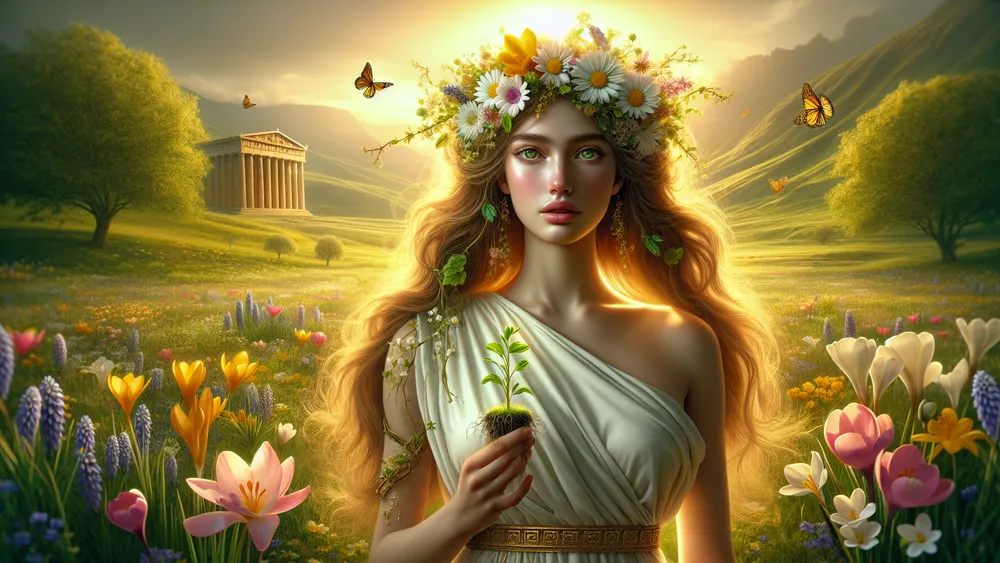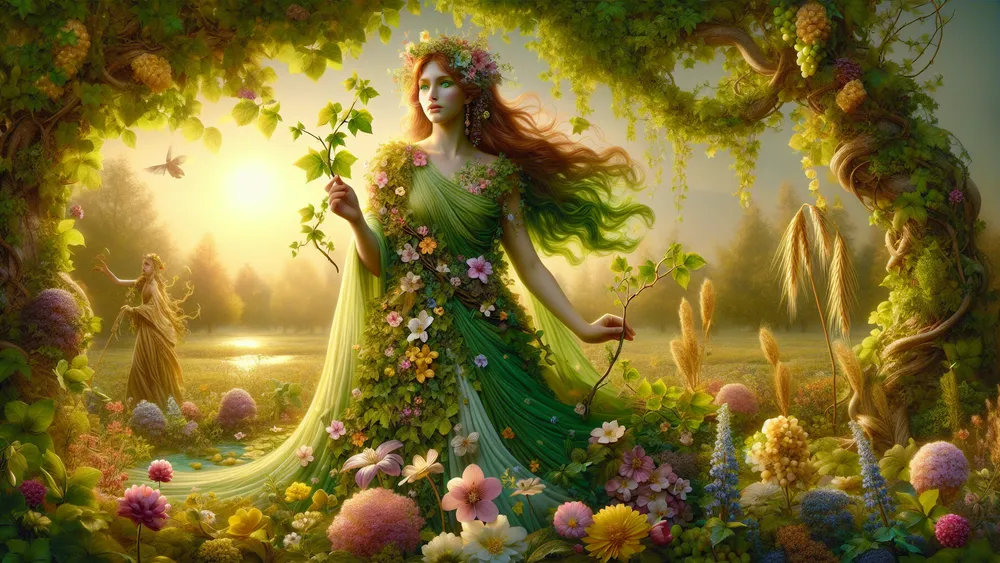Thallo: Greek Goddess Of Spring, Youth, And Blooming Life
In old Greek stories about gods and goddesses, many of them acted as symbols of natural forces, tying them to the patterns of life that shaped the way the world worked. One example of this idea is Thallo, the goddess connected to Spring, youth, and all that is full of life and blooming.
Key Points:
- Thallo, the Greek goddess of Spring, youth, and blooming life, is tied to plant growth and fertility during Spring.
- Her name means to sprout or to bloom, symbolizing renewal and growth in nature.
- Thallo is one of the Horae, goddesses who keep seasons and life cycles flowing smoothly, working alongside her sisters Auxo and Carpo.
- She focuses on the start of nature’s cycle, sprouting plants and filling the land with fresh growth.
- While not widely worshiped, Thallo was connected to farming rituals and Spring celebrations, marking nature’s renewal.
- Her role is different from Persephone’s; Thallo represents active blooming, while Persephone deals with seasonal transitions and life cycles.
- Thallo’s influence is part of a teamwork approach with other gods tied to growth, balance, and the agricultural process.
How do plants begin to grow, or how does the earth seem to come back after the cold days of winter? For the people of ancient Greece, they didn’t see such things as random or by chance. Instead, they believed these changes were controlled by powerful figures like Thallo.
As one of three Horae goddesses, who were tied to the seasons and the natural balance, Thallo’s part in the yearly shift toward growth and renewal was important. She had a strong connection to farming, youth, and the soil’s fertility, meaning her presence was essential to ideas about life starting fresh.
But even though Thallo’s name doesn’t come up as much as famous gods like Demeter or Persephone, the role she played mattered a lot when people thought about the cycle of life starting over. This blog takes a closer look at her role in the natural order, her relationships with both people and gods, and the ways she was celebrated as Spring came every year.
Thallo: Overview and Key Facts
| Key Fact | Details |
|---|---|
| Name and Meaning | Thallo comes from the Greek word thallo, which means “to sprout” or “to bloom.” This helps explain her part in plants growing and flourishing. |
| Role in Mythology | Thallo is the goddess connected to Spring, youth, and blooming life. She stands for the energy of nature during the time when everything starts fresh again and is tied to farming. |
| Mythological Group | She is one of the Horae, a group of goddesses who keep the cycles of life and nature running smoothly. Thallo is specifically tied to Spring and growth. |
| Domain and Symbolism | Her role is linked to plants, flowers blooming, youthful energy, and all that comes with Spring. She represents ideas like growth, fertility, renewal, and how things in nature work together. |
| Associated Deities | Thallo works alongside her sisters, Auxo (growth goddess) and Carpo (harvest goddess), keeping the seasons in order. |
| Iconography | Thallo does not appear much in ancient art, but she can be imagined as a young figure surrounded by flowers, showing her connection to Spring. |
| Cultural Impact | While people didn’t worship her as much as other gods, farmers often saw her as important, as she was tied to farming and Spring rituals. |
| Key Myths | With the Horae, she is part of myths that focus on the natural cycles, showing how gods work together to maintain life. |
Who Is Thallo? The Goddess of Blooming Life
To really see why Thallo is important, we need to explore her role as a goddess who is closely connected to nature’s patterns. Each Spring, she plays a major part in how life begins again. First, we can look at how she fits with the Horae and the meaning behind her name.
Thallo: A Horae and Her Role in Life’s Natural Rhythms
Thallo is one of the Horae, a group of three goddesses from Greek mythology who were tied to the natural order and the seasons. The word Horae, meaning “hours” or “seasons,” described their job, which was to keep nature’s timing and the flow between seasons smooth.
Thallo, whose role focused on Spring, stood for the season of new life beginning, when rest for the earth ends, and fresh starts happen. This season was very important to the Greeks because it began the agricultural cycle. Spring was the time when plants began to grow, fields turned green, and people could hope for future harvests.
Instead of being a goddess who observed from afar, Thallo was believed to take action, making sure that growth and fertility returned after Winter. For the ancient Greeks, seeing nature come back to life felt connected to something divine. This is why Thallo had an obvious place in their beliefs, showing how nature and the divine world were fully linked.
Modern science explains changes in seasons, but in ancient Greece, Thallo’s work meant life starting fresh. Her role stood out in the process of growth and balance in nature. When plants grew taller, flowers opened, and wheat began to appear, people believed Thallo was at work. She represented growth, youth, and renewal. Her connection to youth also reflected ideas about potential and possibilities, like what a field looks like before the harvest.
But her existence was only part of a bigger system. Along with her sisters, Auxo and Carpo, Thallo’s Spring season led into both growth and the end result of harvests. This cycle of the Horae showed how life worked in harmony, with each goddess helping something begin, develop, or finish. Thallo’s point in the cycle was the beginning of it all.
Thallo, one of the Horae goddesses, represented Spring and was believed to actively bring growth, renewal, and the start of the agricultural cycle in ancient Greek beliefs.
What Thallo’s Name Means and Why It Matters
Thallo, a goddess from Greek mythology, has a name tied to her most important role. Her name comes from the Greek word thallo (θαλλώ), which means “to sprout” or “to bloom.” This word represents the moment when new life begins. In myths, the names of gods didn’t just explain who they were. They also meant something important about what they did.
The name Thallo is about plants growing for the first time, signaling the start of Spring, and showing that life always comes back after winter ends. For the ancient Greeks, who depended directly on farming, the sprouting of plants wasn’t just about science. It was deeply connected to their faith.
When they saw fields and plants begin to grow after months of rest, they believed it was proof that life could flourish again. Her name reminded people of this key part of nature’s cycles. From barren ground to full harvests – this was how the Greeks linked what they saw to Thallo’s role.
Here is how Thallo’s name connects to what she represents:

- Growth: Her name stands for sprouting, which connects directly to the early growth of seeds and plants.
- Springtime and Change: The word thallo describes Spring when flowers and nature are at their most colorful and alive.
- Farming and Survival: Since blooming is so essential for growing crops, her name also points to her role in helping agriculture succeed.
- New Beginnings: Plants come back to life every year. Her name explains her job in bringing renewal and energy to the world after Winter.
Stories of Thallo with Gods and Mortals
Thallo was part of the Horae, a group of three goddesses who kept the natural order and the smooth transition between the seasons. She worked with other gods to keep life running in cycles, focusing on the growth of plants and the return of youth each year.
Thallo’s name isn’t as well-known as the Olympian gods, but her presence was understood through the way the seasons followed each other and how life seemed to appear again after Winter. Her two sisters, Auxo, who looked after plant growth, and Carpo, who was tied to the harvest, worked with her to keep the whole process complete. Together, they made sure that planting, growing, and harvesting all stayed in an unbroken order.

The role of each goddess was like how people cared for plants: one started the process, another helped it continue, and the last brought it to its end. This shared work placed them alongside gods like Demeter, who was tied to farming, and showed that Thallo’s role was part of a larger, connected system that helped the world stay balanced.
Thallo’s own stories are hard to find, but her role can be seen in rituals tied to farming. The ancient Greeks relied on their crops to survive, so they likely asked for her help during planting or Spring festivals, though we don’t have myths about her directly meeting mortals. Her connection with her sisters, Auxo and Carpo, also explains how she fit into a natural cycle.
She brought life and youth, worked with Auxo’s focus on growth, and led into Carpo’s part of harvest and plenty. In some stories, the Horae were gatekeepers for Olympus, which meant they kept time and nature moving in an orderly way. For people, this likely meant honoring Thallo in early Spring, when plants began to grow, and life reappeared in the fields.
Even without direct myths, people understood her importance every time the earth began producing life again.
Meet Thallo’s Sisters: The Other Horae
Thallo’s role, focused on blooming life, is closely connected to the work of her two sisters, Auxo and Carpo, who share responsibility for other phases of the natural cycle. Within Greek mythology, the Horae – the group that included the three sisters – were seen as representations of the seasons or nature itself. They helped explain how time and nature worked as an ongoing process.
Auxo, whose name means “to grow” or “to increase,” looks after the first stage, when seeds start to sprout and grow into healthy plants. She ensures that life begins properly. Carpo, whose name means “fruit” or “harvest,” takes care of the last stage in this cycle, when plants are ready to give their fruits and the earth provides its rewards. Together, these three Horae worked as a team.
Auxo started things, helping small plants grow. Thallo made sure these plants reached their blooming and flourishing stages. Carpo finished the process, where the crops were ready, bringing abundance from nature.
Their work can be compared to the steps of growing crops: helping plants sprout at the start, watching them bloom, and finally collecting their fruits in the end. Their roles meant that no single part of life’s process stood alone – each one mattered to the bigger purpose of keeping nature running. Below is a closer look at their contributions:
- Auxo (Growth): Looks after seeds and early buds, helping them grow into healthy plants.
- Thallo (Blooming): Responsible for the blooming period, connected to Spring and the energy of life.
- Carpo (Harvest): In charge of the harvest stage, completing nature’s cycle with fruits and crops.
Thallo’s Role in Springtime Celebrations and Rituals
The ancient Greeks valued Thallo for her role in nature, especially in connection to Spring. They didn’t just think about what she meant; they acted on it. This was done through festivals and ceremonies that happened when Spring arrived, which was when her role in renewal and new life became clear. Through these traditions, they linked her to planting, growing, and starting fresh.
These rituals, which honored her connection to life and agriculture, explain how much a part of the cycle of nature she really was.
Festivals and Traditions Celebrating Thallo’s Spring Energy
The Anthesteria was one of the most important festivals in ancient Greece. It was held for Dionysus, the god connected to wine and fertility, and happened during the arrival of Spring, a time when nature woke up again after the stillness of Winter. This festival gives us a good idea of how people celebrated deities like Thallo, related to cycles of life and growth.
There isn’t clear proof that Thallo was directly worshiped during the Anthesteria, but the theme of renewal fits well with her role. The festival, which involved opening new wine, decorating homes with flowers, and other activities for growth and abundance, meant that the Earth was starting over. Communities came together and marked this change by honoring the forces responsible for nature beginning again.

Thallo, who was tied to youth and blooming life, was likely part of this, even if her name wasn’t directly spoken during these events. At the same time, festivals like the Anthesteria were about more than celebrating the season. They were tied to crops growing well and forming bonds between people, both of which were very important in Greek life.
Farmers might have carried out small rituals or watched for signs in nature to help with planting, and they may have thought about goddesses like Thallo during this. Even if bigger gods like Dionysus or Demeter were the focus, Thallo and the other Horae were closely tied to these ideas.
Their work of keeping the seasons and supporting nature’s energy was likely felt in these events. Combining celebrations with practical needs like farming made these rituals meaningful in a lasting way. Thallo’s part in the rhythm of blooming and renewal helped ensure it all stayed balanced.
The Anthesteria festival celebrated the renewal of life and nature’s cycles, focusing on deities like Dionysus while indirectly reflecting the role of figures like Thallo in supporting growth, balance, and community ties.
Spring Traditions Linked to Thallo’s Influence
In ancient Greece, the start of Spring was a significant time for farmers. It meant the beginning of planting and getting ready for crops to grow. People relied on the cycles of nature, including renewal and growth, and rituals were common to honor the gods tied to these cycles. Thallo, as the goddess of blooming life, stood for the crucial moment when plants first began to sprout.
Though no records mention specific worship of Thallo, she was recognized in spirit as part of what made a successful planting season possible. Farmers often gave the first seeds of the season to the gods in rituals. This was a way to say thanks and to ask for help with the work ahead.
Similar traditions involved preparing the soil, which was part of festivals marking the arrival of Spring, and people believed these ceremonies helped crops begin to grow. Other activities included decorating homes with flowers, which stood for life and growth, and gathering as a community to start planting the fields together.
Below are examples of agricultural traditions tied to Thallo’s role:
- Blessing the Seeds: It was common for farmers to dedicate seeds to the gods in a ritual. This act was a way to pray for their growth and protection.
- Seasonal Soil Preparation: Plowing the land at the beginning of Spring was part of festivals, and farmers believed it helped the soil support new crops.
- Floral Decorations: People used fresh flowers to decorate homes and altars, which meant starting fresh and bringing life into their surroundings.
- Community Planting Ceremonies: Groups of farmers worked together to begin sowing crops, turning the act into both a practical and symbolic start to the season.
Thallo and Nature’s Other Guardians of Growth
Thallo has an important part in the life cycle of blooming plants. But she is also part of a network of Greek gods, each of whom manages different parts of nature, such as growth and renewal. Together, they help us see how the world’s cycles are tied together in Greek mythology.
The roles these gods take on point to how organized and made up of many parts the natural world is, as seen in their myths.
Thallo vs. Persephone: How They’re Different
In Greek mythology, Thallo and Persephone each play an important role in nature, but they focus on different parts of how the world changes. Thallo is one of the Horae and represents the blooming season of Spring. Her work focuses on the sprouting of plants, the growth of youth, and the active time when nature begins to thrive.
She is directly connected to the growth and energy seen in plants during warmer months. On the other hand, Persephone has a different role. She is the queen of the Underworld and daughter of Demeter. Her story is tied to seasonal changes, and her time moving between the Underworld and Earth means both the end of Winter and the start of Spring’s renewal.
Her work reflects the natural cycles where life begins, ends, and starts over again. Unlike Thallo, whose role is about plants blooming, Persephone’s role explains the bigger shifts between seasons.
Below is a comparison of their roles:
| Aspect | Thallo | Persephone |
|---|---|---|
| Role | Goddess of blooming plants and early growth | Queen of the Underworld; goddess of death and rebirth |
| Symbolism | Growth, youth, and vitality | Life, death, and nature’s cycles |
| Mythology | One of the Horae tied to Springtime | Central to the myth of seasonal change through her journey |
| Domain | Active plant growth and the thriving season of Spring | The transition periods between Winter’s stillness and Spring’s start |
This comparison helps us see how Thallo looks after specific growth in plants during the season of Spring, while Persephone focuses on the larger cycle of life and death, showing how nature’s rhythms continually repeat themselves.
Thallo and the Other Plant Deities in Greek Myths
Thallo has a unique but connected role among the Greek gods who are tied to plants. Unlike Demeter, who looks after farming and the food people need to live, Thallo focuses on the early stages of life’s return. This is the time when plants begin to sprout, and flowers first appear.
Her role stands for the energy and growth of early Spring, which is when nature starts to come back to life. Her work is also not the same as Dionysus, the god who oversees wine, fertility, and wild plant growth. His influence is more about untamed things and celebrations tied to plants. In contrast, Thallo works as something more organized and steady.
She is part of the Horae, the goddesses who make sure that the natural order of the world stays balanced and moves forward. To think of this more practically, you could compare them by stages of plant life. Thallo focuses on sprouting and flowering. Demeter takes charge of growing food and keeping it going. And Dionysus adds to the later stages, where the fruits of plants are used and enjoyed.
Together, their jobs mean that each part of growth has a place in the way nature works.

Stories of Renewal: Myths That Feature Thallo
Thallo is a figure in Greek mythology linked to blooming life, youth, and the times when nature begins again. Stories about her are often focused on how nature restarts its cycles and how the seasons stay in balance as time passes. These myths help people understand her role in the larger patterns of growth and the way life continues in Greek myths.
Thallo’s connection to these ideas explains her importance in myths about renewal and harmony.
A Springtime Tale That Points to Thallo’s Power
There are no individual stories about Thallo that are as famous as the ones about bigger Greek gods. However, her work within the Horae gives an important understanding of how she helps life start again. One story that includes the Horae describes them as guardians of the natural order. Together, they lead the transitions between the seasons and make sure the Earth stays rich and balanced.
People notice her part the most at the start of Spring. It is likely the ancient Greeks thought of Thallo as walking across the land, making plants that had been still wake up again. She helps sprouts rise from the soil and fills the land with growing plants.
She works with her sisters, Auxo, who looks after plants as they keep growing, and Carpo, who watches over the ripening harvests. Their shared actions mean that nature can stay alive and healthy. The role of the Horae was not only symbolic but also tied deeply to agriculture. Farmers, knowing that their crops depended on the seasons, prayed to Thallo before planting so their fields would have a strong start.
Without her part in the Horae’s teamwork, Spring would come late. Crops might not sprout, leading to hunger for everyone. Thallo was a way for the Greeks to connect their survival to the gods, where each season and its change was important for the world to keep working.
Her influence is seen in festivals, prayers, and the belief that the gods directly shaped daily life.
Forces of Nature in the Greek Pantheon
The Greek gods include many figures and beings who handle natural and abstract forces, where each one represents part of the universe or human life. Thallo, as a goddess of blooming life, helps explain how the gods were tied closely to patterns in the natural world and how people could survive. The godly presence was not limited to big stories.
It appeared in simple, everyday things too, like fields growing, the turning of seasons, or the balance between life and death. If you’d like to see a full list of all the Greek Abstract and Natural Forces, you can explore how each force was represented and celebrated in this complex system of mythology.
FAQs
1. Was Thallo worshiped extensively in ancient Greece?
Thallo was not worshiped extensively in ancient Greece, as her veneration was more symbolic and tied to seasonal and agricultural contexts rather than widespread cult practices.
2. What distinguishes Thallo from other agricultural deities?
What distinguishes Thallo from other agricultural deities is her exclusive focus on the blooming phase of plant life and the vitality of Spring’s renewal, rather than the entire agricultural cycle.
3. Are there surviving dedications to Thallo in Greece today?
Surviving dedications to Thallo in Greece today are scarce, as her worship was likely overshadowed by more prominent deities in the Greek pantheon.
4. Did Thallo symbolize more than just agricultural growth?
Thallo symbolized more than just agricultural growth by embodying the broader concepts of youth, vitality, and the renewal of life itself.






